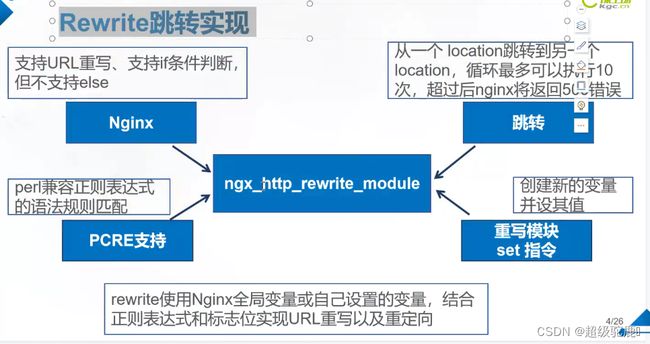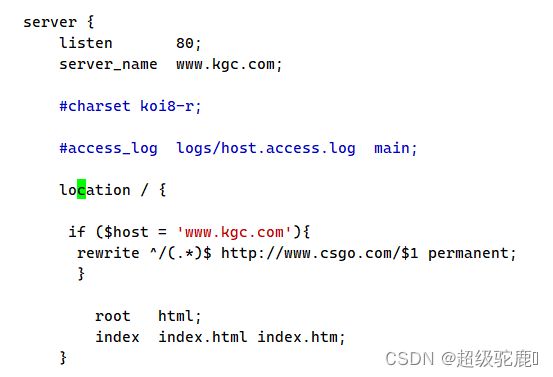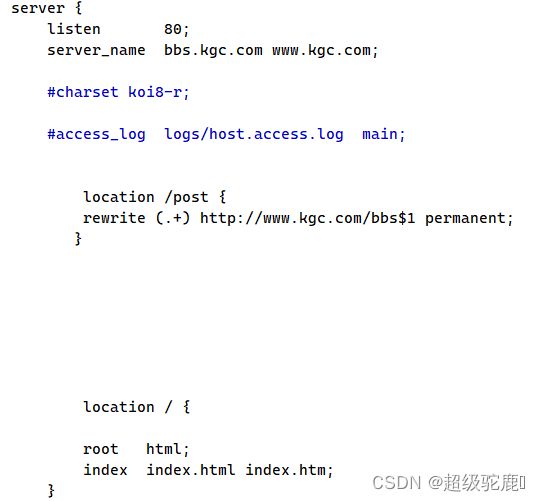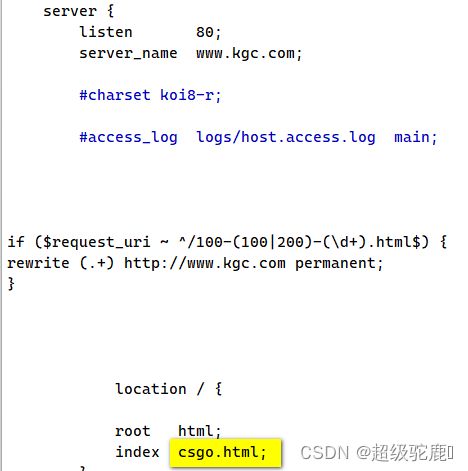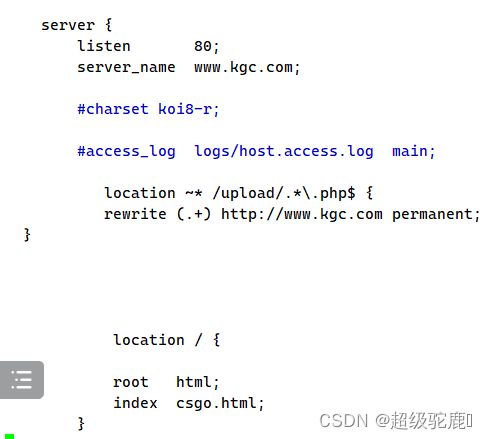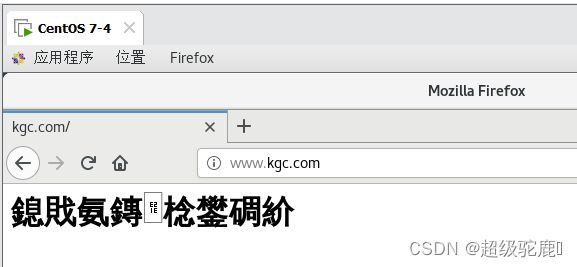Nginx、location匹配、Rewrite重写模块
Nginx、location匹配、Rewrite重写模块
- 一、常用的Nginx正则表达式
- 二、location匹配概述
-
- 1、location大致可以分为三类
- 2、location常用的匹配规则
- 3、location 优先级
- 4、location 示例说明
- 5、实际网站使用中,至少有三个匹配规则定义
- 三、rewrite重写
-
- 1、rewrite 跳转场景
- 2、rewrite 跳转实现
- 3、rewrite执行顺序
- 4、rewrite语法格式
- flag标记说明
- 可用来判断的表达式
- 可用作判断的全局变量
- 四、rewrite 示例
-
- 1、基于域名的跳转
- 2、基于客户端 IP 访问跳转
- 3、基于旧域名跳转到新域名后面加目录
- 4、基于参数匹配的跳转
- 5、基于目录下所有 php 结尾的文件跳转
- 6、基于最普通一条 url 请求的跳转
- rewrite重写Web练习
一、常用的Nginx正则表达式
| ^ | 匹配输入字符串的起始位置 |
|---|---|
| $ | 匹配输入字符串的结束位置 |
| * | 匹配前面的字符零次或多次。如“ol*”能匹配“o”及“ol”、“oll” |
| + | 匹配前面的字符一次或多次。如“ol+”能匹配“ol”及“oll”、“olll”,但不能匹配“o” |
| ? | 匹配前面的字符零次或一次,例如“do(es)?”能匹配“do”或者“does”,”?”等效于”{0,1}” |
| . | 匹配除“\n”之外的任何单个字符,若要匹配包括“\n”在内的任意字符,请使用诸如“[.\n]”之类的模式 |
| \ | 将后面接着的字符标记为一个特殊字符或一个原义字符或一个向后引用。如“\n”匹配一个换行符,而“ ”则匹配“ ”则匹配“ ”则匹配“” |
| \d | 匹配纯数字 |
| \w | 匹配字母或数字或下划线或汉字 |
| \s | 匹配任意的空白符 |
| \b | 匹配单词的开始或结束 |
| {n} | 重复 n 次 |
| {n,} | 重复 n 次或更多次 |
| {n,m} | 重复 n 到 m 次 |
| [] | 定义匹配的字符范围 |
| [c] | 匹配单个字符 c |
| [a-z] | 匹配 a-z 小写字母的任意一个 |
| [a-zA-Z0-9] | 匹配所有大小写字母或数字 |
| () | 表达式的开始和结束位置 |
| l | 或运算符 |
- 从功能看,rewrite 和 location 似乎很像,都能实现跳转,主要区别在于 rewrite 是在同一域名内更改获取资源的路径,而 location 是对一类路径做控制访问或反向代理,还可以 proxy_pass 到其他机器。
二、location匹配概述
1、location大致可以分为三类
| 精准匹配 | location = / {} |
|---|---|
| 一般匹配 | location / {} |
| 正则匹配 | location ~ / {} |
2、location常用的匹配规则
| = | 进行普通字符精确匹配,也就是完全匹配 |
|---|---|
| ^~ | 表示普通字符匹配。使用前缀匹配。如果匹配成功,则不再匹配其它 location |
| ~ | 区分大小写的匹配 |
| ~* | 不区分大小写的匹配 |
| !~ | 区分大小写的匹配取非 |
| !~* | 不区分大小写的匹配取非 |
3、location 优先级
首先精确匹配 =
其次前缀匹配 ^~
##匹配到后不再往下匹配##
其次是按文件中顺序的正则匹配 ~或~*
然后匹配不带任何修饰的前缀匹配
最后是交给 / 通用匹配
4、location 示例说明
(1)location = / {}
=为精确匹配 / ,主机名后面不能带任何字符串,比如访问 / 和 /data,则 / 匹配,/data 不匹配
再比如 location = /abc,则只匹配/abc ,/abc/或 /abcd不匹配。若 location /abc,则即匹配/abc 、/abcd/ 同时也匹配 /abc/。
(2)location / {}
因为所有的地址都以 / 开头,所以这条规则将匹配到所有请求 比如访问 / 和 /data, 则 / 匹配, /data 也匹配,
但若后面是正则表达式会和最长字符串优先匹配(最长匹配)
(3)location /documents/ {}
匹配任何以 /documents/ 开头的地址,匹配符合以后,还要继续往下搜索其它 location
只有其它 location后面的正则表达式没有匹配到时,才会采用这一条
(4)location /documents/abc {}
匹配任何以 /documents/abc 开头的地址,匹配符合以后,还要继续往下搜索其它 location
只有其它 location后面的正则表达式没有匹配到时,才会采用这一条
(5)location ^~ /images/ {}
匹配任何以 /images/ 开头的地址,匹配符合以后,停止往下搜索正则,采用这一条
(6)location ~* \.(gif|jpg|jpeg)$ {}
匹配所有以 gif、jpg或jpeg 结尾的请求
然而,所有请求 /images/ 下的图片会被 location ^~ /images/ 处理,因为 ^~ 的优先级更高,所以到达不了这一条正则
(7)location /images/abc {}
最长字符匹配到 /images/abc,优先级最低,继续往下搜索其它 location,会发现 ^~ 和 ~ 存在
(8)location ~ /images/abc {}
匹配以/images/abc 开头的,优先级次之,只有去掉 location ^~ /images/ 才会采用这一条
(9)location /images/abc/1.html {}
匹配/images/abc/1.html 文件,如果和正则 ~ /images/abc/1.html 相比,正则优先级更高
优先级总结:
(location =) > (location 完整路径) > (location ^~ 路径) > (location ~,~* 正则顺序) > (location 部分起始路径) > (location /)
5、实际网站使用中,至少有三个匹配规则定义
第一个必选规则
直接匹配网站根,通过域名访问网站首页比较频繁,使用这个会加速处理,比如说官网。
这里是直接转发给后端应用服务器了,也可以是一个静态首页
location = / {
proxy_pass http://tomcat_server/;
}
第二个必选规则
处理静态文件请求,这是nginx作为http服务器的强项
有两种配置模式,目录匹配或后缀匹配,任选其一或搭配使用
location ^~ /static/ {
root /webroot/static/;
}
location ~* \.(html|gif|jpg|jpeg|png|css|js|ico)$ {
root /webroot/res/;
}
第三个通用规则
比如用来转发带.php、.jsp后缀的动态请求到后端应用服务器
非静态文件请求就默认是动态请求
location / {
proxy_pass http://tomcat_server;
}
三、rewrite重写
- rewrite功能就是使用nginx提供的全局变量或自己设置的变量,结合正则表达式和标记实现URL重写以及重定向。
例如:更换域名后需要保持旧的域名能够转到新的域名上、某网页发生改变需要跳转到新的页面、网站防盗链等等需求。 - rewrite只能放在server{},location{},if{}中,并且默认只能对域名后面的除去传递的参数外的字符串起作用。
例如:http://www.lucien.com/a/we/index.php?id=1&u=str 只对/a/we/index.php重写。
1、rewrite 跳转场景
- 调整用户浏览的URL,看起来更规范,呵护开发及产品人员的需求
- 为了让搜索引擎搜寻网站内容及用户体验更好,企业会将动态URL地址伪装成静态地址提供服务
- 网址换新域名后,让旧的访问跳转到新的域名上。例如,访问京东的360buy.com会跳转到jd.com。
- 服务端某些业务调整,比如根据特殊变量、目录、客户端的信息进行URL调整等。
2、rewrite 跳转实现
- Nginx:通过ngx_http_rewrite_module模块支持URL重写、支持if条件判断,但不支持else
- 跳转:从一个location跳转到另一个location,循环最多可以执行10次,超过后nginx将返回500错误
- PCRE支持:perl兼容正则表达式的语法规则匹配
- 重写模块set指令:创建新的变量并为其赋值
3、rewrite执行顺序
- (1)执行server块里面的rewrite指令
- (2)执行location匹配
- (3)执行选定的location中的rewrite指令
4、rewrite语法格式
语法格式:rewrite [flag];
regex:表示正则匹配规则
replacement:表示跳转后的内容
flag:表示rewrite支持的flag标记
flag标记说明
| last | 本条规则匹配完成后,继续向下匹配新的location URI规则,一般用在 server 和 if 中。 |
|---|---|
| break | 本条规则匹配完成即终止,不再匹配后面的任何规则,一般使用在 location 中。 |
| redirect | 返回302临时重定向,浏览器地址会显示跳转后的URL地址。 |
| permanent | 返回301永久重定向,浏览器地址栏会显示跳转后的URL地址。 |
last – 基本上都用这个Flag。
break – 中止Rewirte,不在继续匹配
redirect – 返回临时重定向的HTTP状态302
permanent – 返回永久重定向的HTTP状态301
注:last和break最大的不同在于
- break 是终止当前location的rewrite检测,而且不再进行location匹配
- last是终止当前location的rewrite检测,但会继续重试location匹配并处理区块中的rewrite规则
可用来判断的表达式
-f 和 !-f用来判断是否存在文件
-d 和 !-d用来判断是否存在目录
-e 和 !-e用来判断是否存在文件或目录
-x 和 !-x用来判断文件是否可执行
可用作判断的全局变量
$args #这个变量等于请求行中的参数。
$content_length # 请求头中的Content-length字段。
$content_type # 请求头中的Content-Type字段。
$document_root # 当前请求在root指令中指定的值。
$host # 请求主机头字段,否则为服务器名称。
$http_user_agent # 客户端agent信息
$http_cookie # 客户端cookie信息
$limit_rate # 这个变量可以限制连接速率。
$request_body_file # 客户端请求主体信息的临时文件名。
$request_method # 客户端请求的动作,通常为GET或POST。
$remote_addr # 客户端的IP地址。
$remote_port # 客户端的端口。
$remote_user # 已经经过Auth Basic Module验证的用户名。
$request_filename # 当前请求的文件路径,由root或alias指令与URI请求生成。
$query_string # 与$args相同。
$scheme #HTTP 方法(如http,https)。
$server_protocol # 请求使用的协议,通常是HTTP/1.0或HTTP/1.1。
$server_addr # 服务器地址,在完成一次系统调用后可以确定这个值。
$server_name # 服务器名称。
$server_port # 请求到达服务器的端口号。
$request_uri # 包含请求参数的原始URI,不包含主机名,如:”/foo/bar.php?arg=baz”。
$uri # 不带请求参数的当前URI,$uri不包含主机名,如”/foo/bar.html”。
$document_uri # 与$uri相同。
例:http://localhost:88/test1/test2/test.php
$host:localhost
$server_port:88
$request_uri:http://localhost:88/test1/test2/test.php
$document_uri:/test1/test2/test.php
$document_root:D:\nginx/html
$request_filename:D:\nginx/html/test1/test2/test.php
四、rewrite 示例
1、基于域名的跳转
- 公司旧域名www.lol.com有业务需求变更,需要使用新域名www.csgo.com代替,但是旧域名不能废除,需要跳转到新域名上,而且后面的参数保持不变。
vim /usr/local/nginx/conf/nginx.conf
server {
listen 80;
server_name www.kgc.com; #域名修改
#charset utf-8;
#access_log /var/log/nginx/www.lol.com.access.log; #日志修改
location / {
#添加域名重定向
if ($host = 'www.kgc.com'){ #$host为rewrite全局变量,代表请求主机头字段或主机名
rewrite ^/(.*)$ http://www.csgo.com/$1 permanent; #$1为正则匹配的内容,即域名后边的字符串
}
root html;
index index.html index.htm;
}
}
浏览器输入模拟访问 http://www.lol.com/test/1.html
会跳转到www.csgo.com/test/1.html,查看元素可以看到返回301,实现了永久重定向跳转,而且域名后的参数也正常跳转。
2、基于客户端 IP 访问跳转
- 公司业务新版本上线,要求所有 IP 访问都显示一个固定维护页面,只有公司 IP :192.168.24.74访问正常。
vim /usr/local/nginx/conf/nginx.conf
server {
listen 80;
server_name www.lol.com; #域名修改
#charset utf-8;
#access_log /var/log/nginx/www.kgc.com-access.log main; #日志修改
#设置是否合法的IP标记
set $rewrite true; #设置变量$rewrite,变量值为boole值true
#判断是否为合法IP
if ($remote_addr = "192.168.24.74"){ #当客户端IP为192.168.24.74时,将变量值设为false,不进行重写
set $rewrite false;
}
#除了合法IP,其它都是非法IP,进行重写跳转维护页面
if ($rewrite = true){ #当变量值为true时,进行重写
rewrite (.+) /weihu.html; #重写在访问IP后边插入/weihu.html
}
location = /weihu.html {
root /var/www/html; #网页返回/var/www/html/weihu.html的内容
}
location / {
root html;
index index.html index.htm;
}
}
mkdir -p /var/www/html/
echo 'hello weihu!' > /var/www/html/weihu.html
systemctl restart nginx
浏览器访问
只有 IP 为 192.168.24.74 能正常访问,其它地址都是维护页面
3、基于旧域名跳转到新域名后面加目录
- 我们访问 http://www.kgc.com,现在需要将这个域名下面的访问都跳转到http://www.csgo.com/lucien
vim /usr/local/nginx/conf/nginx.conf
server {
listen 80;
server_name www.kgc.com; #域名修改
#charset utf-8;
#access_log /var/log/nginx/kgc.com-access.log;
#添加
location /post {
rewrite (.+) http://www.csgo.com/lucien$1 permanent; #这里的$1为位置变量,代表/post
}
location / {
root html;
index index.html index.htm;
}
}
4、基于参数匹配的跳转
- 现在访问http://www.kgc.com/100-(100|200)-100.html 跳转到http://www.kgc.com页面。
vim /usr/local/nginx/conf/nginx.conf
server {
listen 80;
server_name www.kgc.com; #域名修改
charset utf-8;
access_log /var/log/nginx/kgc.com-access.log main;
if ($request_uri ~ ^/100-(100|200)-(\d+).html$) {
rewrite (.+) http://www.kgc.com permanent;
}
location / {
root html;
index csgo.html
}
}
5、基于目录下所有 php 结尾的文件跳转
- 要求访问 http://www.kgc.com/upload/123.php 跳转到首页。
vim /usr/local/nginx/conf/nginx.conf
server {
listen 80;
server_name www.kgc.com; #域名修改
#charset utf-8;
#access_log /var/log/nginx/kgc.com-access.log main;
location ~* /upload/.*\.php$ {
rewrite (.+) http://www.kgc.com permanent;
}
location / {
root html;
index csgo.html
}
}
6、基于最普通一条 url 请求的跳转
vim /usr/local/nginx/conf/nginx.conf
server {
listen 80;
server_name www.kgc.com; #域名修改
#charset utf-8;
#access_log /var/log/nginx/kgc.com-access.log main;
location ~* ^/abc/123.html {
rewrite (.+) http://kgc.com permanent;
}
location / {
root html;
index lol.html
}
}
echo ‘< h1> 我就是闪电!< /h1>’ > /usr/local/nginx/html/lol.html
